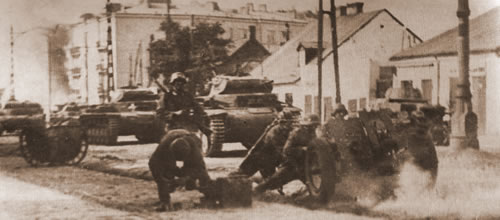Two German Army Groups sped across the borders of Poland on September 1st 1939. Leading the assault that began the Second World War were two Panzer Groups engaged in trapping and destroying the Polish Army in a massive pincer formation.
The Germans were aware that the Polish would be hard to beat psychologically, emboldened by the knowledge that Britain and France would be on their side in any attack, but the Germans had two surprises on their side: 1. They’d made a secret pact with Russia to divide Poland between them in exchange for Russia’s help. 2. The Germans were employing their new form of attack called Blitzkrieg (lightning war), something that had not been possible before the invention of fast tanks and aircraft, so that the Polish were overcome and defeated before any allies could do anything to stop them.
 The Blitzkrieg of Poland required precision teamwork between the commanders of all the forces of the German army, along with a great deal of speed and surprise. Scouting parties led the way, with artillery Forward Observers backing them up and air support from the Luftwaffe Forward Air Controllers, who could spot dangerous targets and call for artillery strikes.
The Blitzkrieg of Poland required precision teamwork between the commanders of all the forces of the German army, along with a great deal of speed and surprise. Scouting parties led the way, with artillery Forward Observers backing them up and air support from the Luftwaffe Forward Air Controllers, who could spot dangerous targets and call for artillery strikes.
As the scouting recon teams spotted potential targets they would not stop, instead they would report what they’d seen and speed on to the next location, or strong point, and keep up the momentum of the advance. Further back, commanders would decide whether or not a target was dangerous enough to bother with then they would either destroy it or ignore it, then sweep through at speed. The commander of the force was in a slightly forward from central location, which the Germans called Schwerpunkt (center of gravity) and when a target was considered a large enough threat to attack, he would wheel the army in the direction of the threat and simply overwhelm it with massive firepower, then wheel the army back to their original course or next major threat – always on the move.
After the initial wave had punched a hole in the Polish lines, another German element would attack what by now would be the rear of the Polish lines, avoiding all the main threats, and creating total mayhem. After this, motorized infantry would follow and clean up any remaining resistance, making sure the Polish army could not regroup again and close any gaps.
A Blitzkrieg required careful planning and an immense amount of accurate communication, teamwork and, above all, total secrecy. There was no preliminary artillery bombardment to ‘soften up’ the enemy. There was no bombing of primary targets by aircraft. There was absolutely nothing to indicate an attack was imminent. Instead, an entire army would rage across the border, like a horde of attacking Zulu warriors with guns, tanks and planes, pummeling the enemy into submission before they even realized they were being hit.
The Blitzkrieg tactic was also used later against the French, in May 1940, when the Germans took over the Low Countries and traversed the Meuse to invade France. The French army was like a disorganized rabble, with their tanks and armor spread piecemeal along their borders, compared to the efficient might of the German Panzer Groups so that, like the Polish, they were overrun and crushed before they realized what was happening. Even the more organized British Expeditionary Force (BEF) had to turn tail and were extremely lucky to escape over the Channel from Dunkirk to England thanks to the Royal Navy and many British civilian volunteers in their own boats, rescuing 330,000 Allied troops. In fact it was only because Hitler ordered his army to halt for three days that the BEF managed to escape, if he had not Britain would have been without an army to defend herself. To this day no one really knows why Hitler ordered the advance to halt.
In just over a month since the Germans crossed the border into France, Paris had surrendered and the French government handed over control to Germany on June 24 1940. Panzers and the Panzerwaffe were at the top of their game.